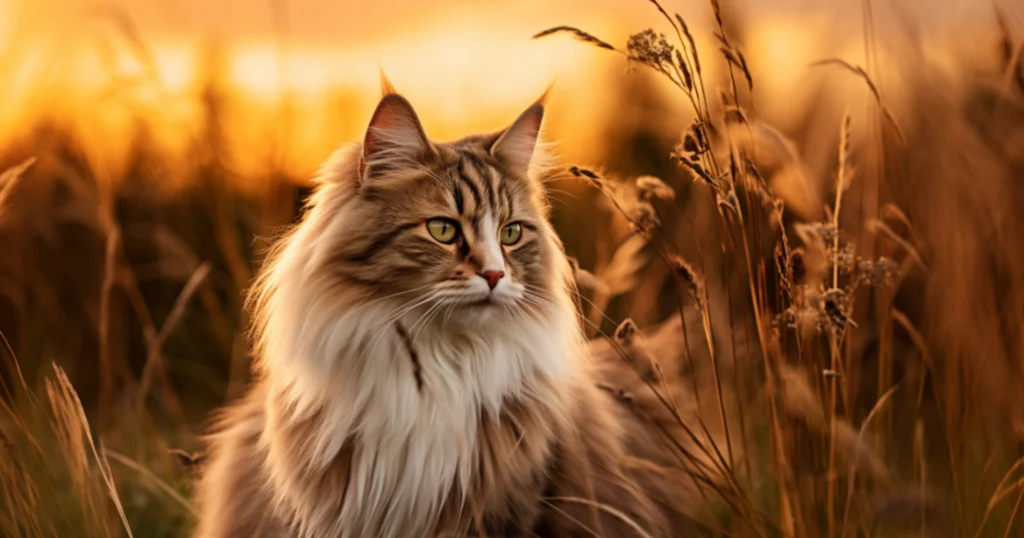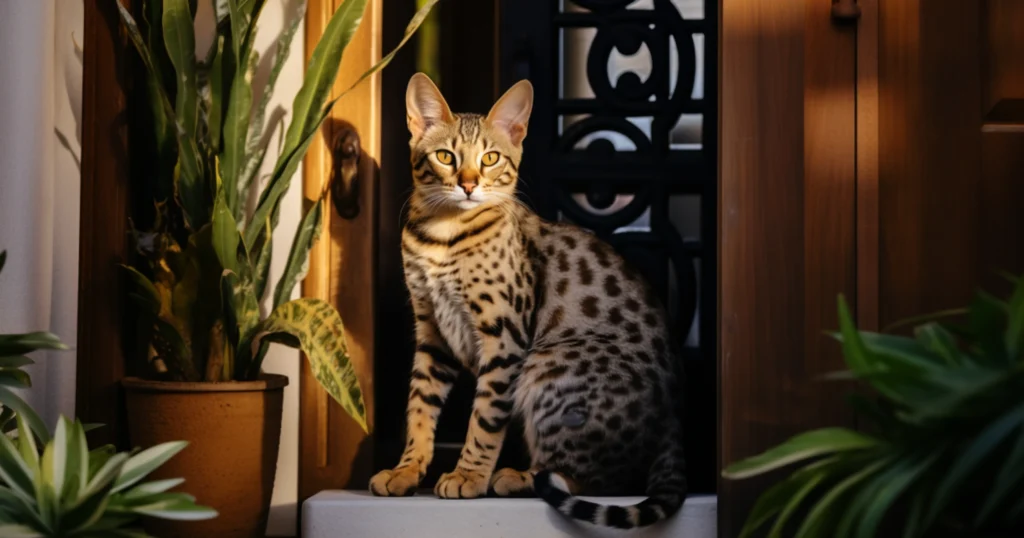The story of Felis catus is a tale as old as time, or at least, as old as our Neolithic ancestors. From the arid expanses of the Fertile Crescent to the cozy corners of modern-day living rooms, the domestic cat has sauntered its way through history with grace, resilience, and an unerring sense of mystery. You see, the journey of our feline companions is not a straightforward tale of domestication as it is with dogs, for example.
Instead, it’s a complex narrative of independence, cohabitation, and a gentle purr of mutual benefits. In this article, we’ll be exploring the wild ancestry of domestic cats, tracing their evolutionary journey from their wild ancestors and taking a closer look at the genetic, geographic, and historical factors that have shaped the cats we share our homes with today. Prepare to be fascinated, cat lovers!
Origins of Domestic Cats

Wild Ancestors
Meet Felis lybica, or the African wildcat, the veritable Adam and Eve of the domestic cat world. These aren’t your common garden variety tabbies, oh no! Think sleeker, more muscular, and boasting a temper more suited to the wild savannas and arid deserts they call home. The African wildcat, a subspecies of wildcat Felis silvestris lybica, is believed to be the ancestral parent of all domestic cats. Despite the stark contrast in environments and lifestyles, our housecats share a staggering 95.6% of their DNA with these wild, desert-dwelling cats. And so began the tango of coexistence, a dance that spanned millennia and evolved into the relationship we know today.
Geographical Origin
And where, pray tell, did this dance take place? The answer lies in the Fertile Crescent, a region that arcs across the Near East from the Nile to the Tigris and Euphrates rivers. This area is famous as the birthplace of agriculture, a veritable cradle of civilization, where humans began to trade their nomadic lifestyles for settled farming. It was here, during the Neolithic period, that humans and Felis silvestris lybica first rubbed shoulders—or, more accurately, ankles. Drawn to the human settlements by the promise of easy meals—think pesky rodents in the grain stores—these wildcats began to hang around. Humans, in turn, welcomed their pest-controlling talents. And voila, the Fertile Crescent became the dancefloor for the first steps of this evolutionary waltz.
Genetic Ancestry of Domestic Cats

Genetic Lineage
Hang onto your hats, folks, because the ancestry rabbit hole—or should we say, “cat burrow”?—goes deeper. DNA, our genetic blueprint, is like the breadcrumbs Hansel and Gretel left in the woods. By following this trail, scientists have managed to trace back the lineage of our domestic moggies all the way to Felis sylvestris. This groundbreaking research has given us a feline version of ‘Ancestry.com,’ if you will. Scientists, using DNA samples from modern-day cats and archaeological remains, found a high degree of genetic overlap. The results were clear: Felis sylvestris, our wild ancestor, had made an indelible mark on the gene pool of today’s household cats.
Present Existence
Now, you may be wondering, does Felis sylvestris still exist today? You bet your catnip they do! This wildcat species continues to prowl the lands of Africa, southern Asia, and Europe, living their ‘wild’ lives, oblivious to their famous descendants. From the sun-scorched plains of Africa to the chilly reaches of Europe, these wildcats are a living testament to the resilience and adaptability of the feline species. So next time you see a domestic cat leisurely stretching in the sun, remember it carries within it a wild legacy that spans continents and epochs. Quite the heritage, eh?
Domestication of Cats

Timeline
Alright, let’s take a trip back in time, approximately 12,000 years ago. Picture it: The Stone Age was coming to a close, humans were ditching their nomadic lifestyle for agriculture, and civilizations were slowly starting to sprout. Amidst all this upheaval, a strange friendship was brewing—a friendship between humans and, you guessed it, cats! It’s hard to pinpoint an exact date, but around this time, cats began to sidle up to human settlements. From the shadows, these independent hunters began their slow transition into domestic life. So, next time you’re staring at a calendar, remember that the bond between cats and humans predates many of the major events you learned about in history class.
Reasons and Process
But why did this wild, independent creature decide to join us by the fireside? The answer lies in the old adage, “keep your friends close and your enemies closer.” The advent of agriculture led to surplus grain storage, attracting all kinds of pesky rodents. For cats, it was an all-you-can-eat buffet. For humans, the cats were a natural pest control. So, it was a win-win situation, and what started as a mutual benefit blossomed into companionship.
The domestication process, unlike dogs’, was not human-directed. Instead, cats sort of domesticated themselves—a testament to their notorious independent streak. Slowly but surely, they became accustomed to human presence, evolving from fearsome predator to affectionate pet. So, the next time your feline friend curls up on your lap, remember it’s the product of thousands of years of self-guided evolution. Now, isn’t that something to purr about?
Coat Patterns

Have you ever wondered why domestic cats have such diverse coat patterns while their wild ancestors generally stick to one look? It’s no fashion statement; it’s actually a clue to their domestication! You see, coat patterns in cats are heavily influenced by genetics. Wildcats, like Felis lybica, typically have a coat of a uniform “tabby” pattern, designed for optimal camouflage. On the other hand, domestic cats, thanks to selective breeding by humans, sport a variety of patterns, from spots to stripes and even solid colors.
Scientists, being the curious bunch they are, use these coat patterns as a distinguishing factor between wild and domestic cats. It’s like a fingerprint, telling a cat’s domestication story. So, next time you’re admiring your pet’s beautiful coat, remember there’s more to it than just good looks—it’s also a tale of their wild past and cozy present. Talk about wearing your history on your sleeve… or rather, your coat!
Cats in Ancient Civilizations

Ancient Egypt
Ever notice how Ancient Egyptians had a thing for cats? No, they weren’t just big-time cat lovers, but they revered cats as sacred beings! Cats were associated with Bastet, the Ancient Egyptian goddess of home, fertility, and childbirth. These furry beings were seen as protectors, keeping away evil spirits and illnesses. Killing a cat, even accidentally, was considered a grave crime. Images of these divine critters adorned walls and sculptures. So, if you’ve got a feline companion, remember—you’re in the company of a creature that was once considered divine!
Other Civilizations
But the Ancient Egyptians weren’t the only ones smitten by our feline friends. Cats curled up in the laps of nobles in Ancient Rome, symbolizing liberty and divinity. The Norse had Freyja, the goddess of love and beauty, whose chariot was drawn by two large cats. And let’s not forget the Japanese, who to this day consider the ‘Maneki-neko’ or the beckoning cat, a symbol of good luck. Even the Mayans depicted the Jaguar, a big cat, as a symbol of strength and dominance in their mythology. Cats have indeed strutted their stuff across human history, haven’t they?
Current Research and Developments

Let’s talk about what’s hot off the press in the world of cat research, shall we? Scientists are now using the latest genetic and archaeological tools to dig deeper into the kitty evolution mystery. A recent breakthrough suggests that domestic cats spread in two waves: first, through the Near East and later, through Egypt.
Another exciting development is the discovery of cat remains in a 5,300-year-old Chinese village, raising new questions about cat domestication in Asia. So, stay tuned—there’s always something new and intriguing around the corner in the fascinating journey of our beloved feline companions!
Conclusion
Well folks, we’ve come a long way in our journey, haven’t we? From the wild expanses of the Fertile Crescent to the cosy corners of our living rooms, cats have sure had an incredible journey. It’s truly fascinating how they’ve evolved from the wild Felis sylvestris lybica into the purring, playful pets we adore today. Even as we marvel at this journey, scientists are continuously peeling back the layers of the past, revealing even more captivating aspects of our feline friends’ history. It seems, the story of cats—our bewhiskered, enigmatic companions—is an ever-evolving tale. And what a tale it is!


